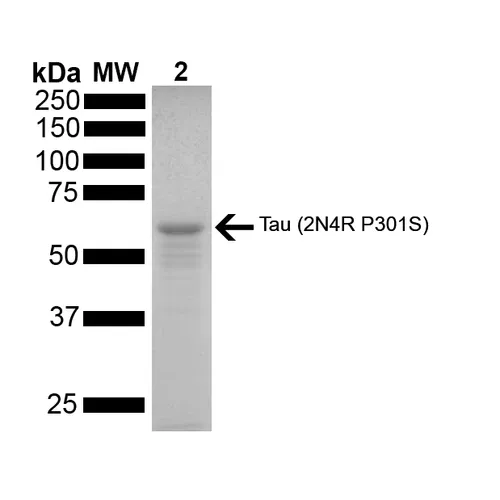Tau-441 (2N4R) P301S Mutant Monomers
CAT:
400-SPR-327E
Size:
5x 100 µg
Price:
Ask
- Availability: 24/48H Stock Items & 2 to 6 Weeks non Stock Items.
- Dry Ice Shipment: Yes






Tau-441 (2N4R) P301S Mutant Monomers
- Background: Alzheimer’s Disease (AD) is the most common neurodegenerative disease, affecting 10% of seniors over the age of 65 (1). It was named after Alois Alzheimer, a German scientist who discovered tangled bundles of fibrils where neurons had once been in the brain of a deceased patient in 1907 (2). Tau (tubulin-associated unit) is normally located in the axons of neurons where it stabilizes microtubules. Tauopathies such as AD are characterized by neurofibrillary tangles containing hyperphosphorylated tau fibrils (3). There are six isoforms of tau in the adult human brain: three with four repeat units (4R) and three with three repeat units (3R) (4). 2N4R, or Tau-441 is the full length tau protein. P301S is a mutation encoded by exon 10 (4) that impairs the ability of tau to assemble microtubules (5).
- Description: Human Recombinant Tau-441 (2N4R) P301S Mutant Protein Monomers
- Product Name Alternative: Tau monomer, Tau protein monomer, Tau protein, microtubule-associated protein Tau, MAPT, MAP, microtubule-associated protein, Tau-441, Paired Helical Filament-Tau, Phf-Tau, Neurofibrillary Tangle Protein, G Protein Beta1/Gamma2 Subunit-Interacting Factor 1, Isoform 2, tubulin-associated unit
- UNSPSC: 12352202
- Gene ID: 4137
- Swiss Prot: P10636
- Accession Number: NP_005901.2
- Cellular Locus: Cytoplasm | Axolemma | Axolemma Plasma Membrane | Axon | Cell Body | Cell membrane | Cytoplasmic Ribonucleoprotein Granule | Cytoplasmic Side | Cytoskeleton | Cytosol | Dendrite | Growth cone | Microtubule | Microtubule Associated Complex | Neurofibrillary Tangle | Neuronal Cell Body | Nuclear Periphery | Nuclear Speck | Nucleus | Peripheral membrane protein | Plasma Membrane | Tubulin Complex
- Host: E. coli
- Origin Species: Human
- Target: Tau-441 (2N4R) P301S Mutant
- Conjugation: No tag
- Sequence: MAEPRQEFEV MEDHAGTYGL GDRKDQGGYT MHQDQEGDTD AGLKESPLQT PTEDGSEEPG SETSDAKSTP TAEDVTAPLV DEGAPGKQAA AQPHTEIPEG TTAEEAGIGD TPSLEDEAAG HVTQARMVSK SKDGTGSDDK KAKGADGKTK IATPRGAAPP GQKGQANATR IPAKTPPAPK TPPSSGEPPK SGDRSGYSSP GSPGTPGSRS RTPSLPTPPT REPKKVAVVR TPPKSPSSAK SRLQTAPVPM PDLKNVKSKI GSTENLKHQP GGGKVQIINK KLDLSNVQSK CGSKDNIKHVSGGGSVQIVY KPVDLSKVTS KCGSLGNIHH KPGGGQVEVK SEKLDFKDRV QSKIGSLDNI THVPGGGNKK IETHKLTFRE NAKAKTDHGA EIVYKSPVVS GDTSPRHLSN VSSTGSIDMV DSPQLATLAD EVSASLAKQG L
- Applications: WB, SDS-PAGE, In vivo assay, In vitro assay
- Purification Method: Ion-exchange Purified
- Concentration: 2 mg/ml
- Purity: >95%
- Activity: Thioflavin T emission curve shows increased fluorescence (correlated to tau protein fibrillation) when tau PFFs are combined with tau monomers.
- Weight: 0.05
- Length: Full Length
- Buffer: 10 mM HEPES, 100 mM NaCl pH 7.4
- Molecular Weight: ~45.8 kDa
- Precautions: Not for use in humans. Not for use in diagnostics or therapeutics. For research use only.
- Additionnal Information: For corresponding PFFs, see catalog# SPR-329
- References & Citations: 1. www.alz.org/alzheimers-dementia/facts-figures 2. Alzheimer, A. Über eine eigenartige Erkrankung der Hirnrinde. Allg. Z. Psychiatr. Psych.-Gerichtl. Med. 64, 146–148 (1907) 3. Matsumoto, G. et al. (2018). Int J Mol Sci. 19, 1497. 4. Goedert, M. and Spillantini, M. G. (2017). Mol Brain. 10:18. 5. Bugiani, O. et al. (1999). J Neuropathol Exp Neurol. 58(6):667-77.
